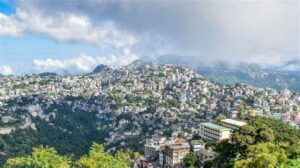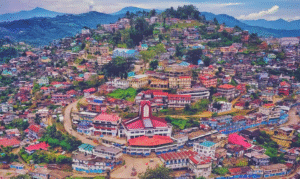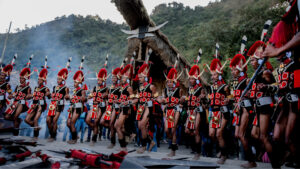Introduction
India is home to a diverse range of cultures, communities, and faith-based traditions. Among the many unique religious and cultural observances found in the Northeastern state of Tripura is Ker Puja—a deeply symbolic and spiritually potent ritual performed with the intention of protecting the people, maintaining harmony, and ensuring the collective welfare of society. Rooted in ancient tribal traditions and later adapted by the royal families of Tripura, this unique puja (ceremonial worship) serves not only as a religious observance but also as a societal safeguard.
This educational and academic blog aims to explore the origin, rituals, social significance, and continuing legacy of Ker Puja, focusing on its intersection of tribal belief systems and governance. Through this, readers will gain insight into the importance of community-centered rituals in the cultural fabric of Tripura.
Historical Origins of Ker Puja
Ker Puja traces its origins to the ancient tribal practices of the indigenous Tripuri people of Tripura. According to oral histories and ethnographic studies, the word “Ker” is believed to refer to a guardian deity or protective spirit. In tribal cosmology, Ker is invoked to ward off evil, protect the boundaries of the kingdom, and ensure the safety and prosperity of its people.
The ritual was institutionalized by the royal family of Tripura, particularly during the reign of the Manikya dynasty, which ruled the region for several centuries until the mid-20th century. It is said that the kings of Tripura, recognizing the spiritual power of tribal practices, incorporated Ker Puja into the state’s official religious calendar. It was often conducted following other major festivals like Kharchi Puja—a festival dedicated to the fourteen deities worshipped by the Tripuri people.
Timing and Duration
Ker Puja is observed according to the traditional Tripuri calendar and typically falls in the month of July, shortly after Kharchi Puja. The date is determined by royal priests and astrologers, often aligning with lunar phases and auspicious planetary positions. The puja lasts for approximately two and a half days and is conducted in the capital city of Agartala, in a designated area called Ker Bari.
Rituals and Ceremonial Practices
1. Sacred Boundary and Isolation
One of the most striking features of Ker Puja is the physical demarcation of a sacred space. The area where the rituals are performed—usually surrounding the royal palace or a sacred grove—is sealed off using bamboo poles, banana leaves, and symbolic barriers. Once the puja commences, no one is allowed to enter or exit the designated area for the entire duration.
This symbolic enclosure represents a spiritual boundary meant to protect the people from malevolent forces. Any breach of this boundary is considered a serious sacrilege and could lead to the entire ritual being restarted.
2. Silence and Prohibition
During Ker Puja, a unique atmosphere of austerity prevails. Loud noises, celebrations, and certain daily activities such as dancing, singing, or cooking elaborate meals are strictly prohibited. The community observes a period of solemn silence and meditation. This is believed to create an atmosphere of spiritual purity and concentration necessary for invoking divine protection.
Additionally, the use of firecrackers, alcohol, and meat is banned within the ritual perimeter. Even funerals and births, if they occur during this time, must be observed quietly and outside the restricted area.
3. Offerings and Sacrifices
The ritual involves traditional offerings such as rice, flowers, incense, and local fruits. In earlier times, animal sacrifices were part of the ceremony—particularly the offering of goats or pigeons to appease the deity Ker. However, in modern practice, symbolic offerings have replaced actual sacrifices in many communities due to evolving ethical considerations and laws.
Priests known as Chantai lead the offerings, chanting sacred mantras in the Kokborok language. These incantations are meant to invite the guardian spirit and ask for protection against diseases, natural disasters, and other social or spiritual ills.
4. Community Participation and Roles
Ker Puja is not a spectator ritual. The entire community, including priests, royal family members, and local residents, have assigned roles. Women generally refrain from participating in the inner sanctum of the puja but contribute through preparing food, organizing the ritual space, and assisting in ancillary rituals.
Young men, selected through community consensus or hereditary tradition, serve as ritual guardians. They observe fasting, silence, and must abstain from any impure or distracting activity. Their dedication represents the collective commitment of the society to maintain order and sanctity.
Symbolic Meanings and Interpretations
Ker Puja can be interpreted on multiple symbolic levels—social, spiritual, and political.
- Spiritual Protection: At its core, the ritual is a plea to the divine for protection. In a region susceptible to seasonal diseases, monsoon-related disasters, and political unrest, Ker Puja functions as a collective spiritual insurance policy.
- Social Cohesion: The restrictions and communal participation foster a sense of unity. Everyone—regardless of caste, tribe, or class—comes together under shared rules and spiritual purpose. This reinforces community bonds.
- Governance and Control: For the royal family, institutionalizing Ker Puja was also a political act. It helped consolidate their rule by aligning themselves with indigenous practices. The physical and spiritual boundaries created during the ritual also symbolized state control and discipline.
Relationship with Kharchi Puja
Although Ker Puja is a distinct festival, it is closely linked with Kharchi Puja. While Kharchi is focused on the worship of the fourteen deities (representing natural and spiritual forces), Ker Puja is more protective and preventative in nature.
Kharchi is a time of grand celebration, music, and feasting. Ker, on the other hand, is a ritual of silence, withdrawal, and purification. Together, they form a complementary cycle—first invoking divine blessings and then safeguarding them through spiritual barriers.
Modern-Day Observance
In present-day Tripura, Ker Puja continues to be observed with devotion, particularly in the old royal precincts of Agartala. Though some of the more austere and esoteric aspects have been softened, the essential components remain intact.
The Tripura government and cultural organizations often sponsor and support the festival as part of efforts to preserve intangible heritage. It is featured in state-sponsored cultural calendars and draws scholars, anthropologists, and even tourists interested in tribal rituals and syncretic religious traditions.
However, challenges persist. Urbanization, religious homogenization, and loss of traditional priesthoods pose threats to the continuity of such rituals. Many younger Tripuris view the practice as outdated or overly restrictive. Nevertheless, elders and cultural custodians work to keep the tradition alive, often adapting it to contemporary sensibilities.
Academic and Anthropological Importance
Ker Puja has been studied in several anthropological and ethnographic contexts. It is a rich case study in:
- Syncretism: The festival combines indigenous animistic practices with Hindu ritualistic elements, demonstrating how tribal cultures adapt to and influence mainstream religions.
- Ritual Theory: Scholars such as Victor Turner and Emile Durkheim would interpret Ker Puja as a liminal event—where societal norms are suspended to renew social order.
- Cultural Resilience: Despite external pressures, the persistence of Ker Puja shows how traditional knowledge systems adapt to survive in changing contexts.
- Political Anthropology: The integration of the puja into royal statecraft illustrates the use of religion for governance and legitimacy.
Conclusion
Ker Puja is more than just a festival—it is a living tradition that reflects the deep interconnection between spirituality, community, and governance in Tripura. Its elaborate rituals, strict observances, and communal focus reveal how societies use religion to cope with uncertainty, protect social cohesion, and preserve cultural identity.
In an increasingly globalized world, such indigenous practices remind us of the importance of rootedness and collective responsibility. As long as there are communities willing to uphold the values of harmony, protection, and reverence for the divine, Ker Puja will continue to be a vital part of Tripura’s cultural and spiritual legacy.






